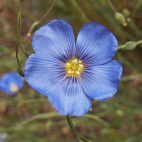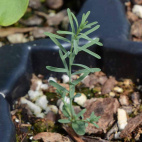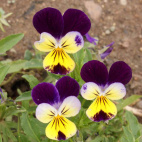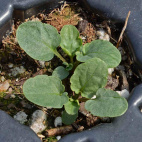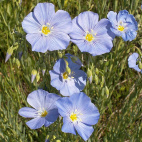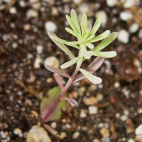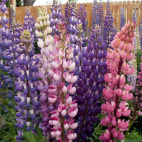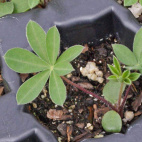Color
Availability
USDA Zone
Region
Type
Duration
Season
Germination
Soil
Sunlight
Height
Use
Narrow Your Search
Color
Availability
USDA Zone
Region
Type
Duration
Season
Germination
Soil
Sunlight
Height
Use
Wildflower Seeds - Mountain Region
The Mountain Region is a diverse area of the Western US that includes the Rockies, Olympics, Sierras, and a host of other mountain ranges. These areas are higher in elevation than the surrounding areas, and so face more extremes in temperature as well as moisture. Generally, the western sides of the mountains are greener than the eastern sides because most of the weather patterns move from west to east. Since the area described here is so vast and variable, you may have to experiment a bit to see exactly what will grow in your micro climate. We cannot tell you exactly what mountain wildflower seeds will grow in your garden because it depends so much on your exact location - a garden a few miles from you may have a totally different climate, rainfall, soils, and daylight. The best thing is to experiment and buy wildflower seeds online, or ask local gardeners or greenhouses if you want localized gardening information.
-
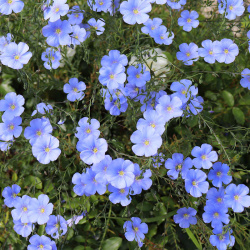 On Sale!
Blue Flax Seeds
Linum perrene
See the sky reflected in a sea of these heavenly blue blooms. This perennial is fast-growing and looks best as a mass planting. It is hard to imagine how this Linum Perrene plant produces such a vibrant color from just water and dirt.Quick View$3.48 Pkt - $7.65 / Oz
On Sale!
Blue Flax Seeds
Linum perrene
See the sky reflected in a sea of these heavenly blue blooms. This perennial is fast-growing and looks best as a mass planting. It is hard to imagine how this Linum Perrene plant produces such a vibrant color from just water and dirt.Quick View$3.48 Pkt - $7.65 / Oz -
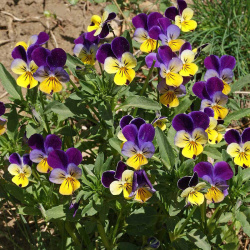 Helen Mount Johnny Jump Up Seeds
Viola tricolor
With cheery purple, yellow, and white faces, this charming wildflower looks a mini version of the pansy. This petite beauty often reseeds itself and springs up voluntarily year after year.Quick View$3.48 Pkt - $14.07 / Oz
Helen Mount Johnny Jump Up Seeds
Viola tricolor
With cheery purple, yellow, and white faces, this charming wildflower looks a mini version of the pansy. This petite beauty often reseeds itself and springs up voluntarily year after year.Quick View$3.48 Pkt - $14.07 / Oz -
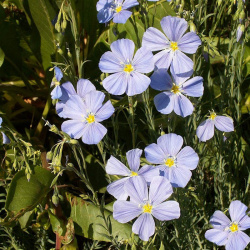 Lewis Flax Seeds
Linum lewisii
This western native grows in lovely, pale blue profusion, and is named after the Lewis and Clark expedition. It is similar to Blue Flax but is a little shorter, and not quite as vivid. Some gardeners like to mix the two varieties to create a bit more texture in the planting. This perennial is very easy to grow and looks great when planted en masse.Quick Viewx
Lewis Flax Seeds
Linum lewisii
This western native grows in lovely, pale blue profusion, and is named after the Lewis and Clark expedition. It is similar to Blue Flax but is a little shorter, and not quite as vivid. Some gardeners like to mix the two varieties to create a bit more texture in the planting. This perennial is very easy to grow and looks great when planted en masse.Quick ViewxLewis Flax Seeds
Linum lewisii
This western native grows in lovely, pale blue profusion, and is named after the Lewis and Clark expedition. It is similar to Blue Flax but is a little shorter, and not quite as vivid. Some gardeners like to mix the two varieties to create a bit more texture in the planting. This perennial is very easy to grow and looks great when planted en masse.
$3.48 Pkt - $12.65 / Oz -
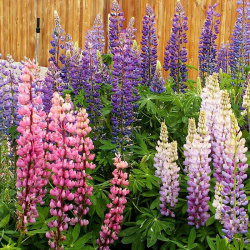 On Sale!
Russell Lupine Seeds
Lupinus polyphyllus
Brilliant and bold in a rainbow of colors; this Lupine variety will provide colorful blooms all season. This flower is a cultivated variety of a Lupine that is native to the Pacific Northwest. It grows so quickly and easily that it can almost be invasive with the right growing conditions.Quick Viewx
On Sale!
Russell Lupine Seeds
Lupinus polyphyllus
Brilliant and bold in a rainbow of colors; this Lupine variety will provide colorful blooms all season. This flower is a cultivated variety of a Lupine that is native to the Pacific Northwest. It grows so quickly and easily that it can almost be invasive with the right growing conditions.Quick ViewxRussell Lupine Seeds
Lupinus polyphyllus
Brilliant and bold in a rainbow of colors; this Lupine variety will provide colorful blooms all season. This flower is a cultivated variety of a Lupine that is native to the Pacific Northwest. It grows so quickly and easily that it can almost be invasive with the right growing conditions.
$3.48 Pkt - $8.20 / Oz
The Mountain Region is a diverse area of the Western US that includes the Rockies, Olympics, Sierras, and a host of other mountain ranges. These areas are higher in elevation than the surrounding areas, and so face more extremes in temperature as well as moisture. Generally, the western sides of the mountains are greener than the eastern sides because most of the weather patterns move from west to east. Since the area described here is so vast and variable, you may have to experiment a bit to see exactly what will grow in your micro climate. We cannot tell you exactly what mountain wildflower seeds will grow in your garden because it depends so much on your exact location - a garden a few miles from you may have a totally different climate, rainfall, soils, and daylight. The best thing is to experiment and buy wildflower seeds online, or ask local gardeners or greenhouses if you want localized gardening information.










